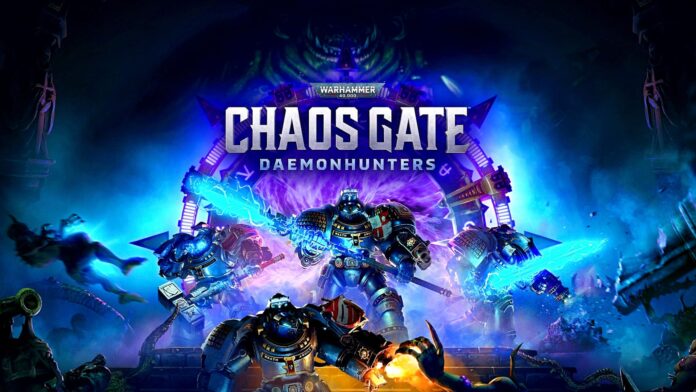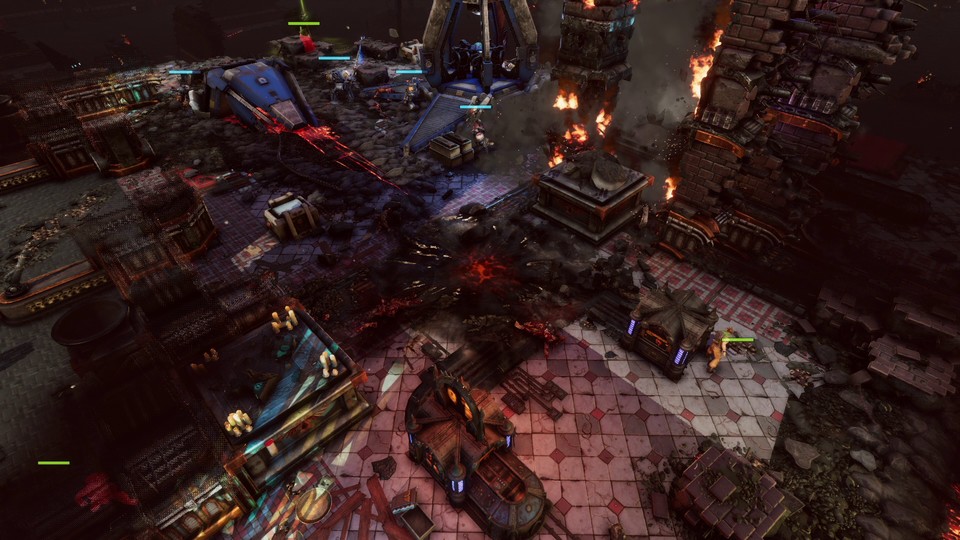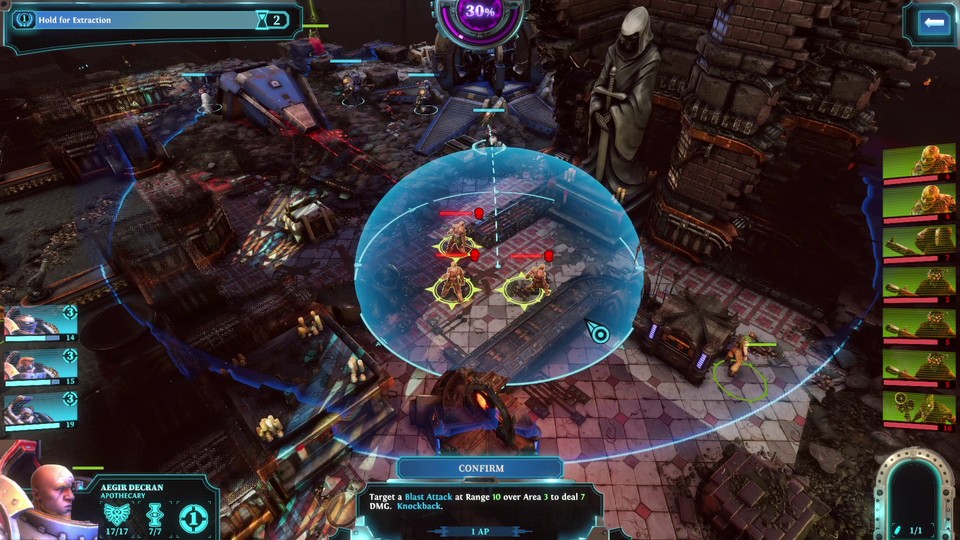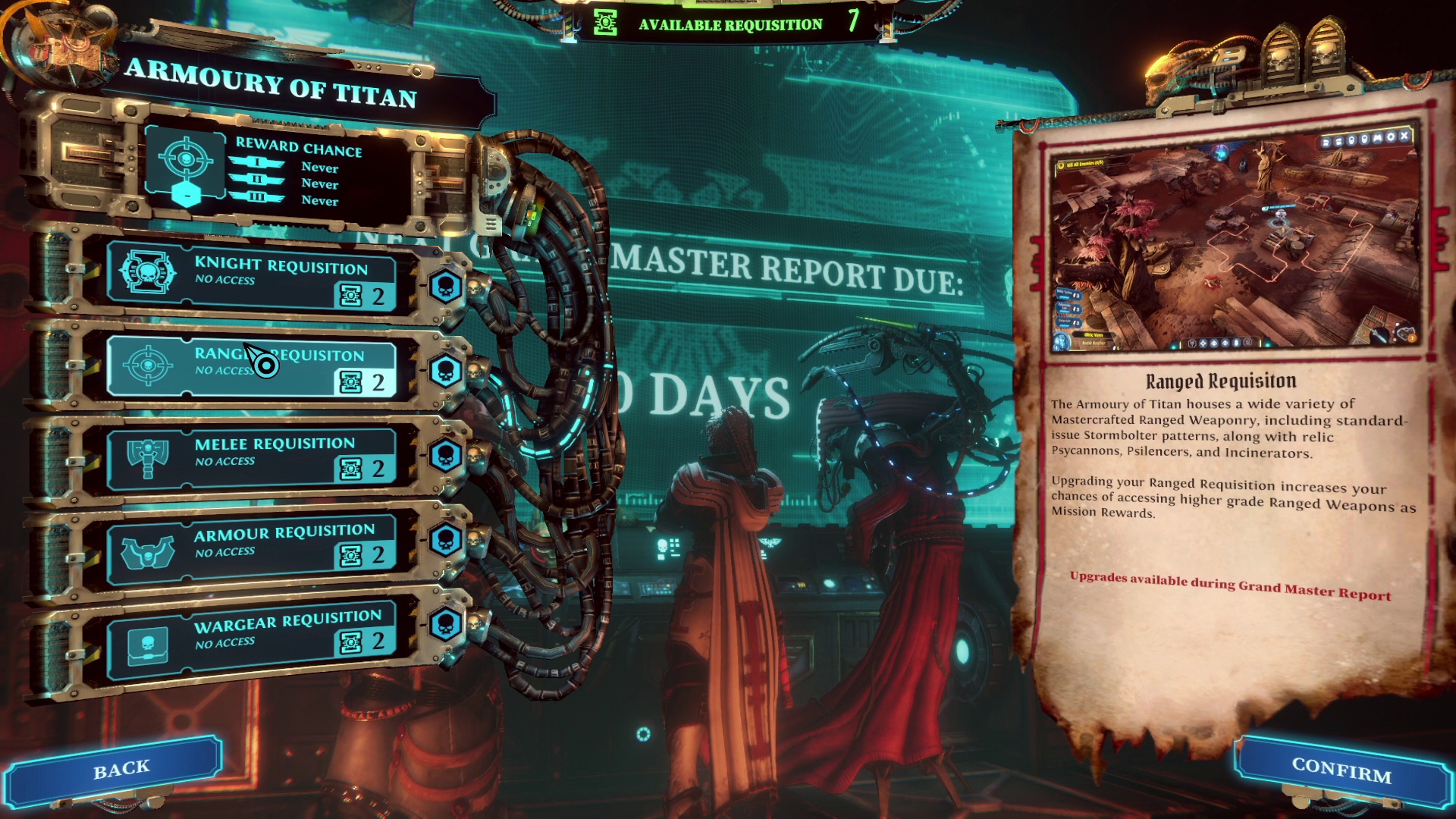Warhammer 40K: Daemonhunters doesn’t reinvent the sublight drive, but doesn’t neglect a single XCOM strength in return. We played the round tactics game with the Space Marines.
Seriously, Space Marines from the Warhammer 40K universe are exorbitant posers in the broadest sense. You can go on and on about how these are efficiency-driven super-soldiers who have dedicated their entire lives to the Empire and fear neither war nor death.
That may all be true, but deep in their hearts Space Marines want to appear cool above all else. This is shown to me in the very first minutes of the game, which I spend in the tutorial of Warhammer 40,000: Chaos Gate – Daemonhunters.
A squad of highly trained elite soldiers gets caught in the middle of a bloody battle against the henchmen of the chaos god Khorne. And of course the marines could just take cover and efficiently blast the manglers or blood demons off the planet from a distance – but no. Space Marines are extra.
They march up in massive armour, after all, with shoulder plates even bigger than their own egos. And of course these plates are also written full of martial slogans like: Purge! Or Sanctuary! They also carry around huge, blue-glowing halberds, or a sword in each hand. Oh, and the healing drone is of course a flying skull.
Equipped in this way, they mop the floor with the war demons before boarding their war cathedral again with proudly swelling chests.
And I tell all this with the utmost respect for this self-dramatisation! Because it’s a very big part of why I had a really good time in my two-hour play session with what is probably the biggest turn-based tactics hopeful since XCOM 2!
Table of Contents
On the shoulders of XCOM
Four full missions including tutorial and a proper boss fight I was able to tackle during my time with Warhammer 40K: Daemonhunter. Of course, it was already known in advance that Daemonhunters takes very large slices from the genre pioneer XCOM 2, accordingly there is no need to get used to it.
The special task force in Daemonhunter consists of four highly qualified demon hunters who, as members of the so-called Grey Knights, are directly subordinate to the Empire’s Inquisition and not, as in XCOM, of sometimes more, sometimes less competent human rebels. From a purely playful point of view, however, this doesn’t make too much of a difference in the first few turns of the battle.
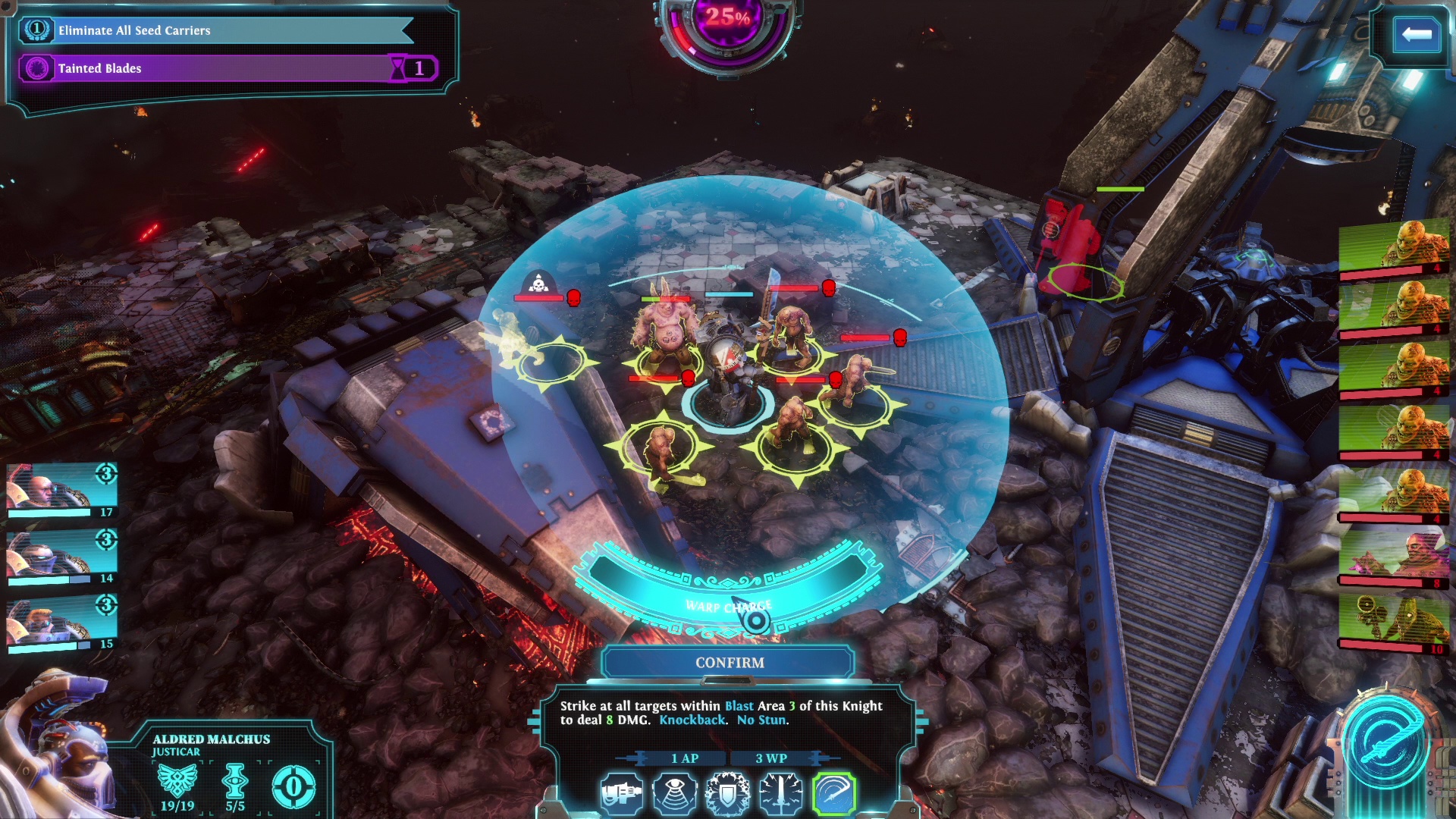
The battlefields are littered with all kinds of cover options and the terrain is also characterised by differences in altitude. The areas are not really extensive, but Daemonhunters doesn’t want to stage epic, sprawling battles, but rather short, intense battles that rarely last longer than 20 minutes and provide varied mission objectives.
In my case, for example, these were the hunt for two demonic seed carriers and the destruction of an infested tree called Bloomspawn. Later on, there was a hand-built boss fight with unique level mechanics.
I navigate my marines through these (very detailed) areas each turn, giving them three action points to do so. This is where Daemonhunters becomes a little unfaithful to XCOM and instead reaches into the toy box of Gears Tactics. Because I can freely divide all these action points between movement and abilities – pleasantly dynamic, that is.
But at its core, it plays extremely familiar. The marines take cover behind obstacles, I have to weigh up well how far they should run and use their special abilities profitably. If I want to complete a move early, a marine simply moves into an Overwatch position and automatically opens fire as soon as an enemy unit comes into his field of vision.
Yes, we’ve seen that more than enough. But it’s the genre standard set by XCOM, and in shooters we don’t complain when a crosshair appears.
The round tactics in the megalomania
The reason Daemonhunters doesn’t feel interchangeable, despite everything, is because of its licence. As superficial as that may sound, in this case Warhammer 40K helps it stand out from the standard genre fare. But the development team has also simply understood quite wonderfully what fans expect.
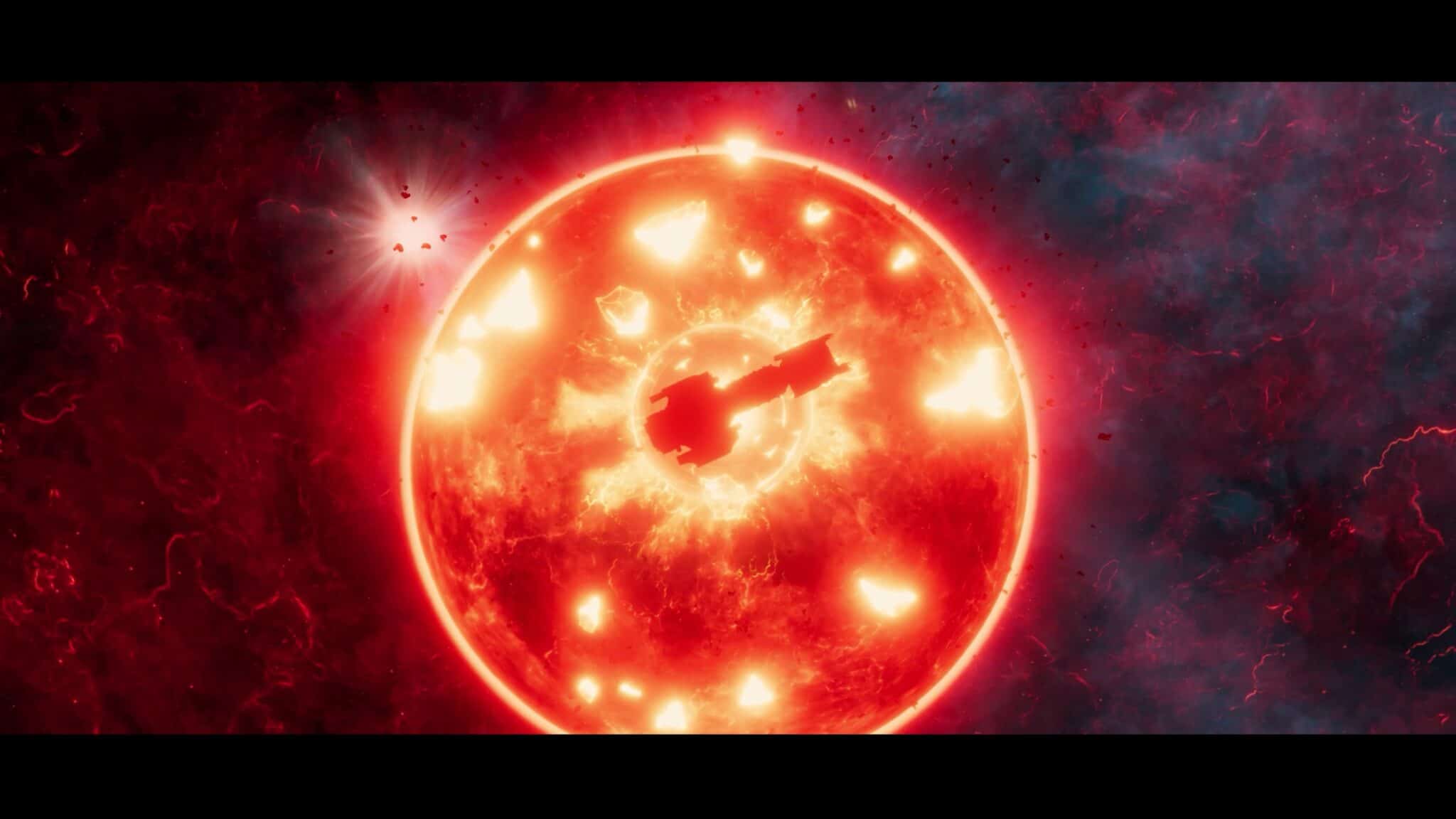
Warhammer is namely a universe that is quite over the top. As emphasised at the beginning, this is already evident from the fanatical plate armour boys. And Chaos Gate doesn’t even try to weave a sober military scenario with a slight sci-fi touch out of Warhammer 40K. Another turn-based strategy game called Battlesector tried that last year and the result was dry-as-dust boredom.
Daemonhunters instead turns the staging knobs up another notch above XCOM. The camera movements, the explosions, the effects and one or two martial sayings capture exactly what distinguishes Warhammer 40K. It’s all about the rough stuff here. Every combat participant probably considers himself the toughest dog in Nurgle’s blooming garden – and most of them get their skulls mercilessly dented in spite of everything. There is always an even tougher dog with even thicker shoulder plates.
This need not and will not please everyone. However, round-robin tactics in particular live to a certain extent from the fact that the developers make the static action as rousing as possible. And Daemonhunter succeeds excellently in this, relying on the megalomania of the Warhammer universe.
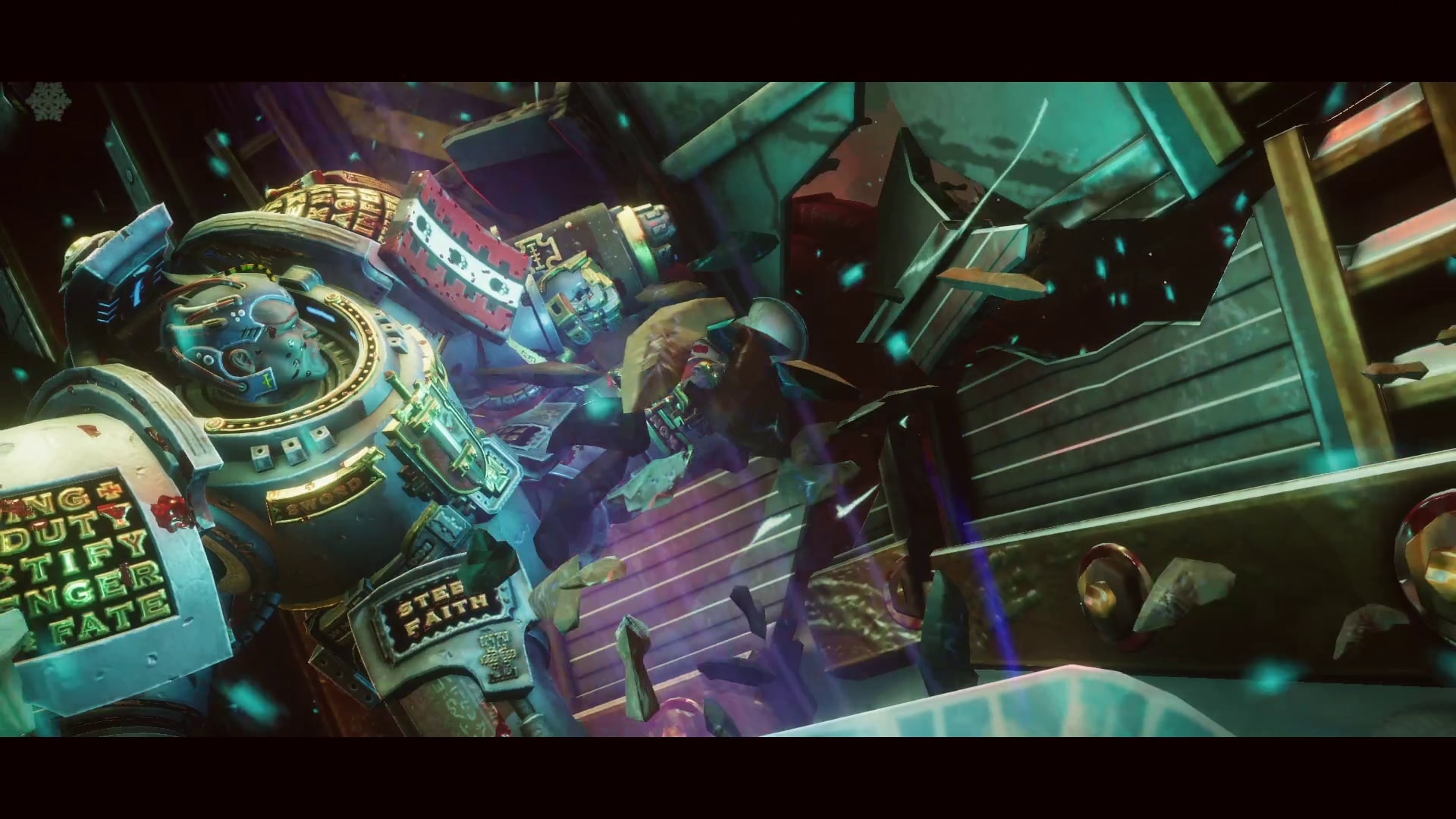
My favourite moment during the entire play session was every time one of the Marines kicked in a door so violently that the concussion was physically felt even by me in front of the screen. It was as if a steam engine had just burst through a wooden barn door.
The coincidence factor – an old controversy
If there is one criticism of XCOM, it almost always concerns the infamous hit chance. Everyone experiences at least once the moment when a high-level agent with a shotgun misses his target from half a metre away. You just don’t forget something like that, it leaves deep scars.
And although Daemonhunters seems so martial, it wants to avoid this mental pain. Ranged attacks are therefore completely free of any coincidences. The developers explain this by saying that a Grey Knight never misses his target. From a purely mechanical point of view, however, this also makes a big difference.
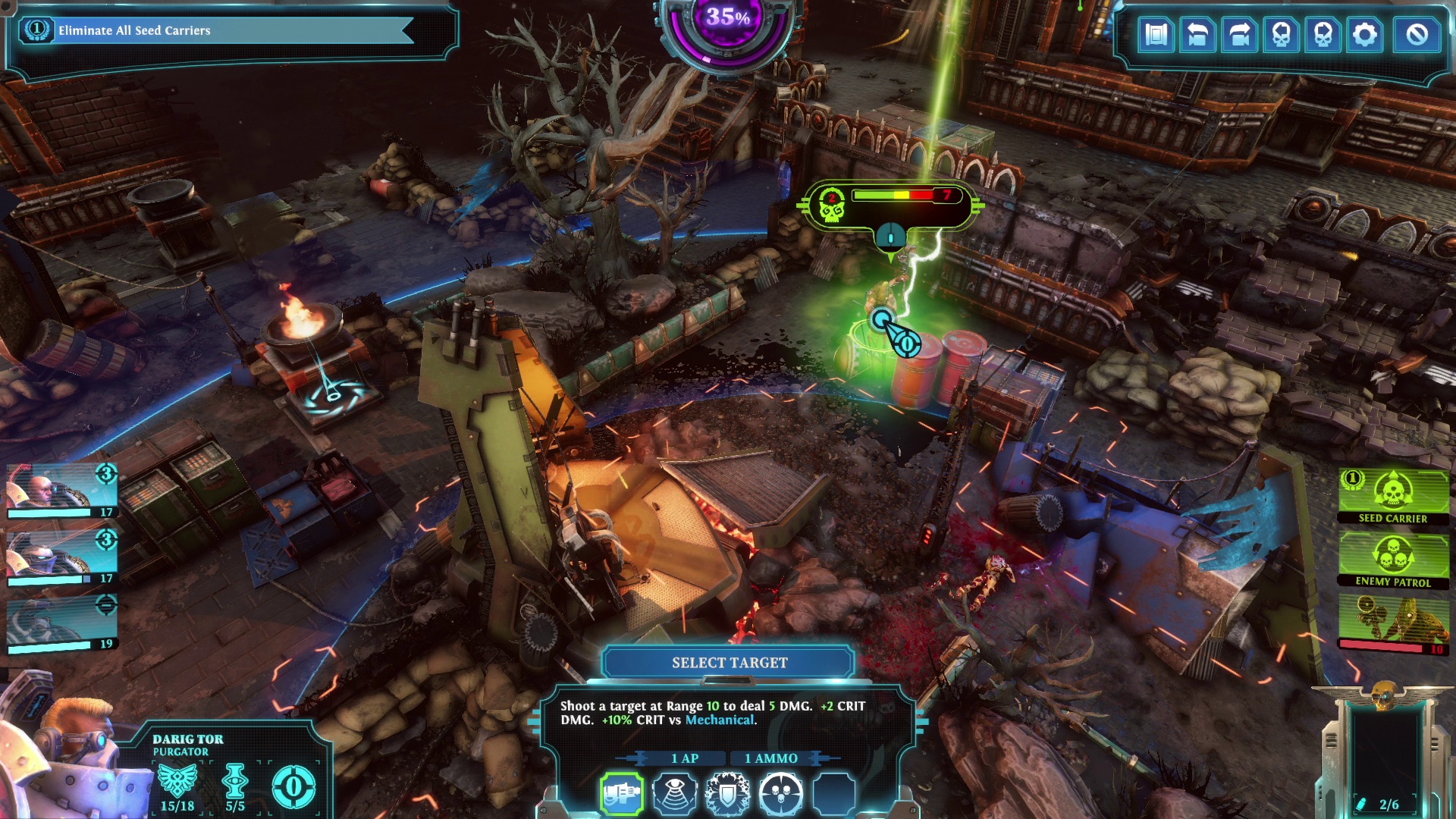
To ensure that outmanoeuvring entrenched enemies without a chance of being hit remains useful, the correct positioning determines the damage dealt. The closer and the better the position, the harder the demonic spawn will be hit.
Especially since the Grey Knights prefer close combat anyway. And here chance can play a role again. If a critical hit is landed, the game switches to a zone view. Here I determine which part of the body will feel the blade. For example, painful debuffs can be imposed or even special abilities can be deactivated by cutting off the body part completely.
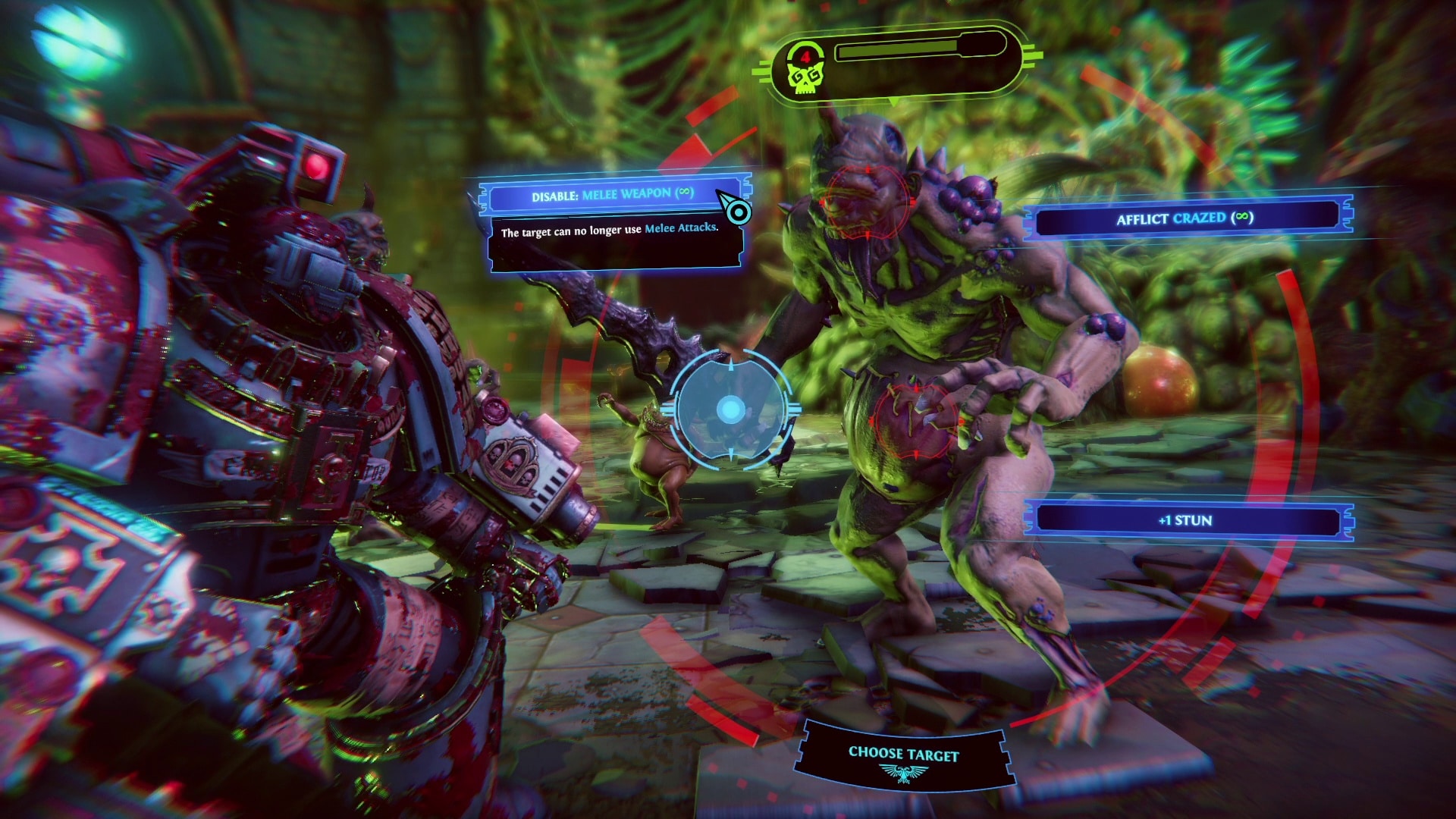
In any case, Daemonhunters was not boring at all, even without random misses. Perhaps a possible XCOM 3 could even take a leaf out of Daemonhunter’s book for a change.
If you still need some form of randomness in your turn tactics for the sake of variance and thrill, Daemonhunters has the Bloom Effect for you. The chaotic perversion caused by a planetary plague called bloom can cause random effects in the course of a battle. Anything else would also be inappropriate to chaos.
It is not yet possible to estimate how far these effects will reach. In my play session, the bloom once caused enemy attacks to paralyse my marines and once created chaos portals through which more enemies poured onto the battlefield.
Onboard the Cathedral of War
No badass Space Marine would ever admit that: But even the Grey Knights need a break from fighting from time to time. Sure, Chaos doesn’t sleep, and the galaxy needs to be cleansed of the demons’ machinations. But for that, the unit has to get from one infested planet to the next, both of which are best done in a headquarters.
And what in XCOM 2 was a huge hovercraft ship is in Daemonhunters our flying war cathedral called Baleful Edict. Baleful Edict – I still say Space Marines are posers.
Okay, let’s leave that and get back to the hard mechanics. Because even on the deck of the Baleful Edict there is more to do than rest. The ship is heavily battered right after the tutorial and is now drifting through the star system infested by the chaos god Nurgle.
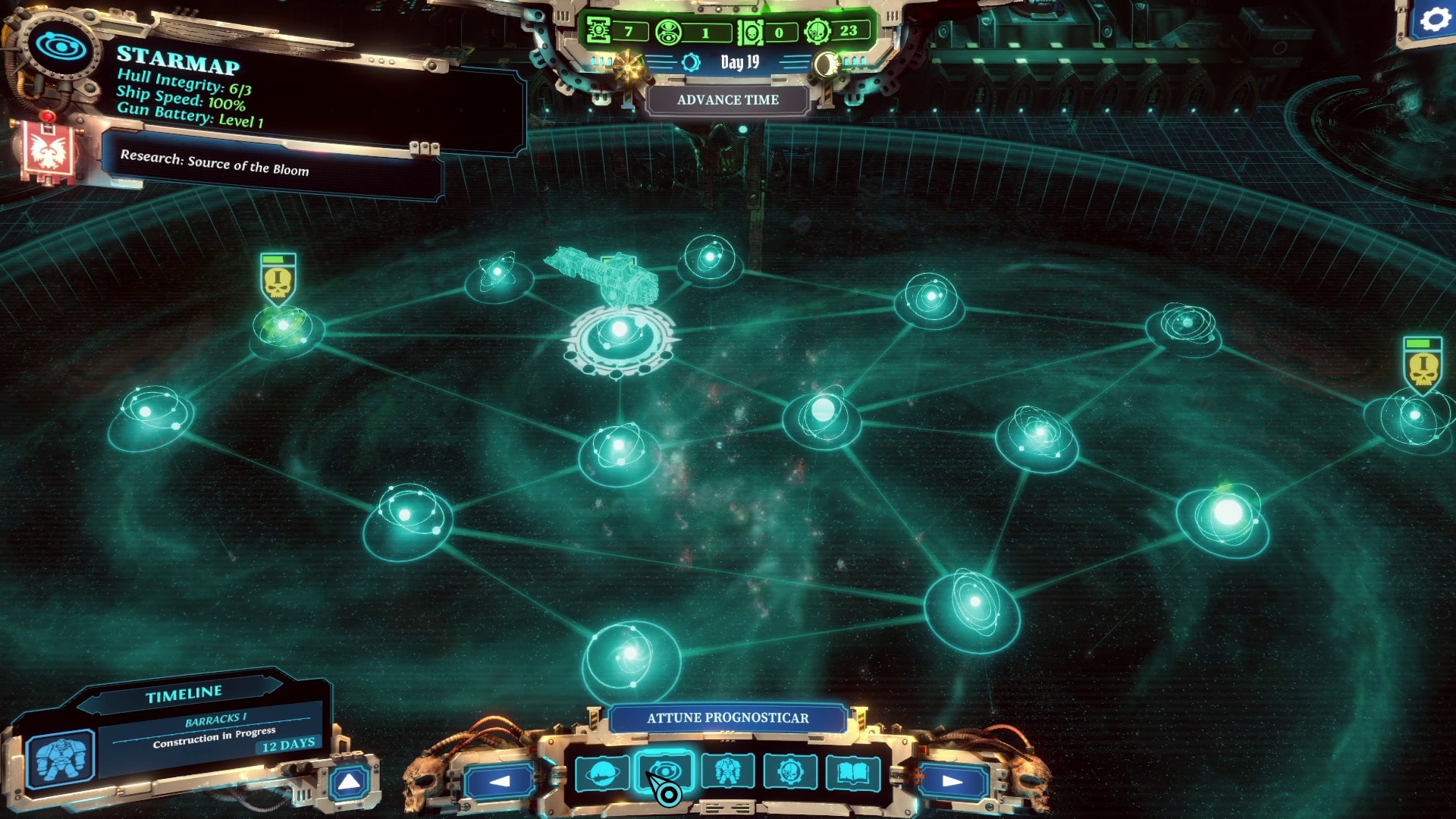
One of the most important tasks is therefore to repair the individual sectors of the ship. For example, I can upgrade the library to increase research speed, or upgrade the warp drive to make the Baleful Edict move faster through the galaxy and make it easier for me to react to problems that arise acutely somewhere. All of this seems appropriately extensive, but not as demanding as space management in XCOM 2.
Inside the ship, the Grey Knights also tinker with improvements that help them on the battlefield. The armoury, with its fulfilled requirements, ensures that the rewards after a successful battle are more lavish, and in the chamber of the Inquisitor Vakir I research so-called stratagems. These are abilities that can be used in combat independently of the available marines.
These are unlocked by Chaos Seeds, which in turn are assigned to other gods. So it’s not just Nurgle who has his poisonous fingers in the pie in Daemonhunters.
Unique Marines
The Space Marines wouldn’t be Space Marines if they didn’t have their very own area on the deck of the Baleful Edict. In their quarters, the soldiers can further their education, but also take the opportunity to dress up really smartly. Because, of course, it’s important for a marine to look fantastically fanatical.
And I say that without sarcasm this time, because customising individual soldiers to one’s own taste was already an aspect that made up a large part of the fun in XCOM. Especially since the fighters can also die permanently, which is even more of a tear-jerker when you’ve spent an hour working on their wardrobe beforehand.
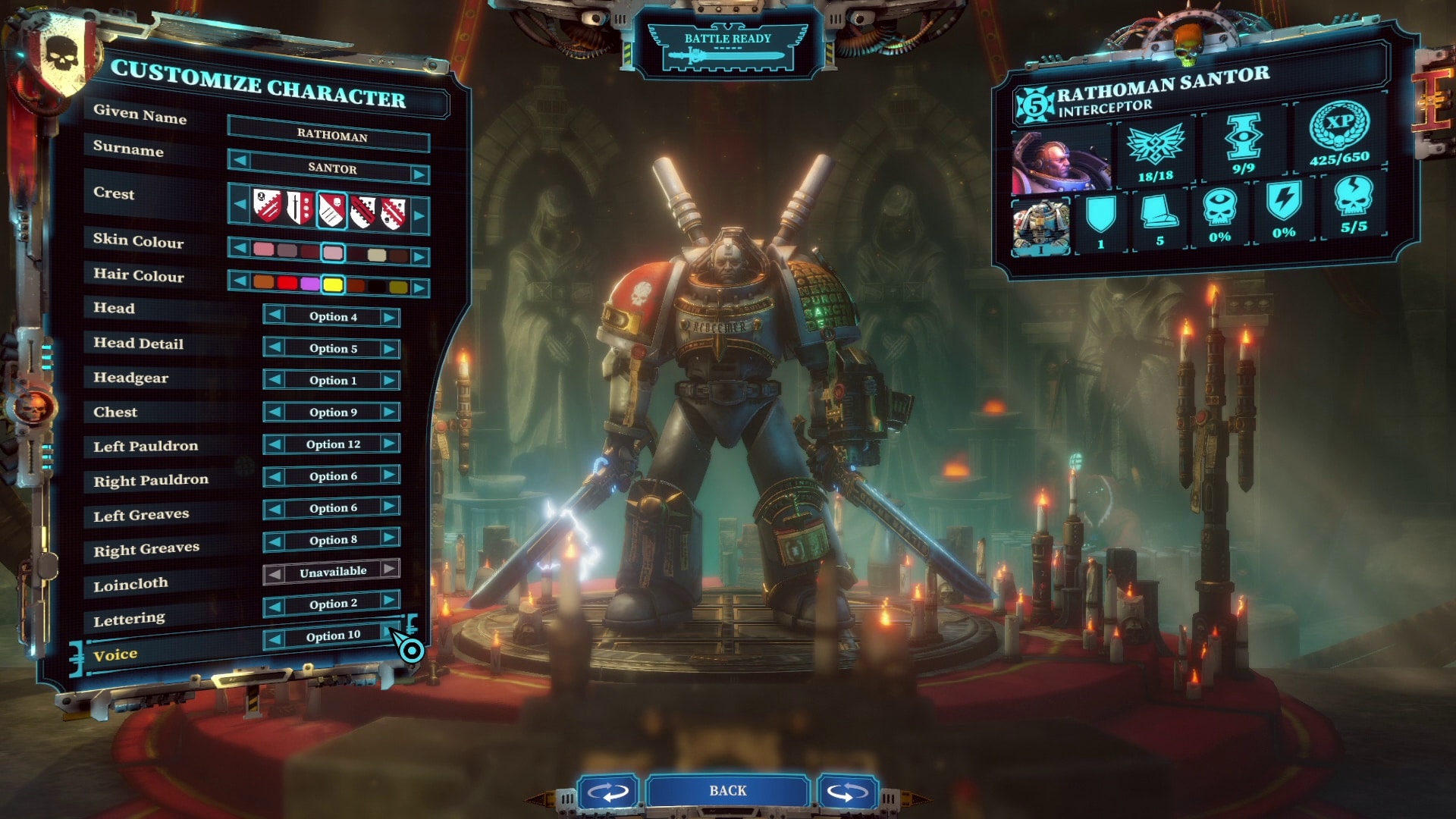
In Daemonhunters I can also change the marines, albeit with considerably more restrictions than in XCOM. Although there are 14 customisable areas from the head to the breastplate to the voice, a Space Marine always remains a Space Marine and it is not possible to do without power armour completely. Those who like to paint tabletop figures will also be disappointed, because apart from hair and skin colour, nothing can be coloured on the figures.
The barracks, however, are not a pure fashion show. For further individualisation, I can give each marine a special loadout and thus decide on ranged and melee weapons or even assign grenades.
In the skill tree, earned warriors level up and unlock other abilities depending on their class:
- Interceptor: Very agile fighters who can get into close combat very quickly with their teleport ability to inflict high damage.
- Justicar: Also reasonably mobile thanks to powerful assault attacks. But more than that, his job is to withstand attacks and perform ranged attacks in close combat.
- Purgator: This class specialises in ranged combat and can also use flamethrowers to make areas impassable.
- Apothecary: The classic supporter tends to stay out of the crossfire and strengthens his allies with buffs or healing.
In terms of depth, Daemonhunters has a lot to offer when it comes to defining the individual marines. However, I wasn’t able to fully exhaust all of the mechanics in my short play session.
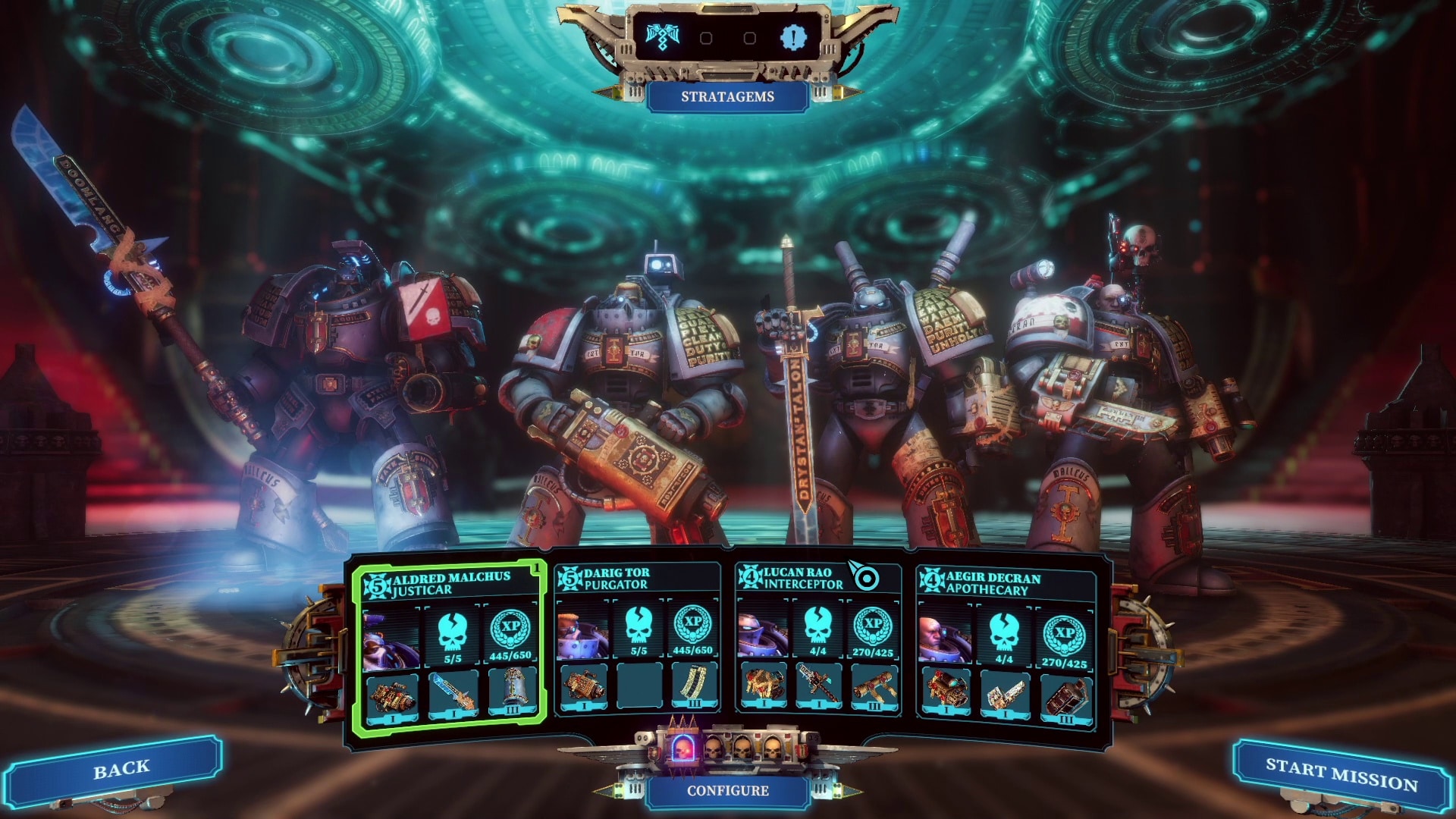
There’s only one thing I’m still completely sure of: Space Marines are posers who pay a lot of attention to their staging. And that is exactly what makes Warhammer 40,000: Daemonhunters so strong! This game doesn’t take any big risks in terms of game mechanics, but simply understands the target group of its licence and combines that with a proven game principle.
In this way, one of the most interesting strategy games of the year can be created without much ado. Let’s hope that this impression remains in the finished game. On 5 May 2022, the time has come.
Editorial conclusion
I never expected Warhammer 40K: Chaos Gate – Daemonhunters to sweep me away like this. Mainly because I’m not the biggest fan of the space version of Warhammer and especially this exaggerated representation of everything and everyone is not that cool. I usually like it more subtle. Not quite so American. But I also like to be wrong and, absurdly enough, I was quite taken by this Warhammer-typical over-staging.
In my opinion, the greatest merit of XCOM 2 was that turn-based tactics were finally staged in a modern and dynamic way. Daemonhunters takes this very much to heart and burns off a much more colourful firework. That was enough to entertain me for at least a few hours.
I also enjoyed the missions and the boss fight against a large Nurgle demon. So I’m sure Daemonhunters has all the ingredients to maybe even become one of the best turn-based strategy games of 2022. At least if the fascination for the brute world doesn’t wear off at some point and the game doesn’t fall by the wayside mechanically.

